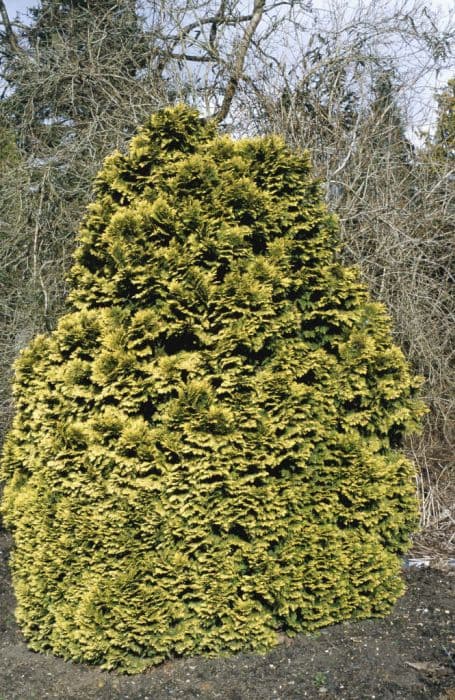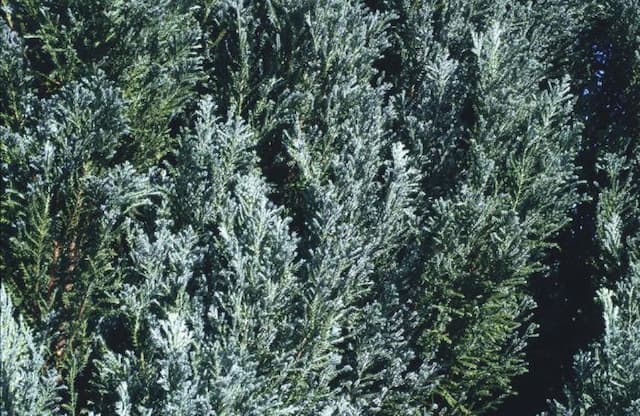Hinoki Cypress Chamaecyparis obtusa 'Kamarachiba'

ABOUT
The Chamaecyparis obtusa 'Kamarachiba', commonly known as Hinoki cypress, is a striking ornamental plant notable for its unique foliage and growth habit. This cultivar exhibits a dense, slow-growing nature with a compact form that gives it a refined and elegant presence in the landscape or garden setting. Its leaves are arranged in flat sprays and possess a rich, deep green color that can add visual depth and interest throughout the year. The texture of the foliage is soft to the touch, with small, scale-like leaves closely packed along the stems. This foliage may exhibit subtle golden-yellow tips, especially when exposed to full sun, which adds a beautiful contrast to the plant's overall deep green hue. The growth pattern of the Hinoki cypress ‘Kamarachiba’ is layered and slightly arching, with branch tips that tend to curve slightly upwards, providing a graceful and somewhat flowing appearance. This gives the plant a distinctive and almost sculptural quality that can stand out in a garden meant for visual appeal. Moreover, as the plant matures, it develops a handsome bark that peels away in strips to reveal reddish-brown shades beneath, providing further textural and visual interest to the plant's appearance. This characteristic bark not only accentuates the visual appeal of the Hinoki cypress during the warmer months but also adds a layer of interest to the winter landscape where the plant's structure is more exposed. The overall presence of the Hinoki cypress 'Kamarachiba' is one of tranquility and natural beauty, making it a cherished selection for those looking to create serene and aesthetically pleasing garden spaces. Its particular form and foliage make it a standout choice for accentuating rock gardens, borders, or even being grown as a standalone specimen in a container.
About this plant
 Names
NamesFamily
Cupressaceae.
Synonyms
Dwarf Hinoki Cypress, Kamarachiba Cypress, Kamarachiba Hinoki Cypress, Miniature Hinoki Cypress.
Common names
Chamaecyparis obtusa 'Kamarachiba'.
 Toxicity
ToxicityTo humans
The Hinoki cypress is not commonly known to be toxic to humans. There are no significant reports of poisoning from ingestion of this plant. However, as with any plant material, individual allergies or sensitivities could potentially cause adverse reactions in some people.
To pets
The Hinoki cypress is also not known to be toxic to pets. It is not listed among plants commonly recognized as poisonous to cats, dogs, or other animals. That being said, the ingestion of any non-food plant material can potentially lead to gastrointestinal upset in pets, such as vomiting or diarrhea, due to the irritation of the stomach or intestines. If a pet is observed eating this plant and adverse symptoms develop, consulting a veterinarian would be advisable.
 Characteristics
CharacteristicsLife cycle
Perennials
Foliage type
Evergreen
Color of leaves
Green
Height
2-3 feet (0.6-0.9 meters)
Spread
2-3 feet (0.6-0.9 meters)
Plant type
Shrub
Hardiness zones
5
Native area
Japan
Benefits
 General Benefits
General Benefits- Ornamental Appeal: Chamaecyparis obtusa 'Kamarachiba', commonly known as Hinoki cypress, features a unique fan-shaped foliage that adds aesthetic value to gardens.
- Dwarf Growth Habit: Its dwarf size allows it to fit in smaller garden spaces or be used in container gardening.
- Low Maintenance: Hinoki cypress requires minimal pruning and is relatively easy to care for once established, making it suitable for many gardeners.
- Evergreen Nature: As an evergreen, it provides year-round color and structure to the landscape.
- Resilience to Weather: It is tolerant to a range of weather conditions, including cold temperatures, once established.
- Erosion Control: Its root system helps prevent erosion, making it a practical choice for slopes or banks.
- Habitat Support: Provides shelter and nesting sites for birds and other wildlife.
- Windbreak: When planted in groups, it can act as a windbreak to protect gardens from strong winds.
- Texture Contrast: Its fine foliage texture contrasts well with plants having larger leaves, which enhances garden design.
 Medical Properties
Medical PropertiesThis plant is not used for medical purposes.
 Air-purifying Qualities
Air-purifying QualitiesThis plant is not specifically known for air purifying qualities.
 Other Uses
Other Uses- Hinoki cypress wood shavings can be used to add a pleasant scent to wardrobe drawers or linen closets, infusing fabrics with its refreshing aroma.
- Woodwork and fine furniture craftsmen may utilize hinoki cypress in the creation of high-quality musical instruments due to its excellent resonance qualities.
- Thin slices of the wood can be crafted into unique business cards or decorative veneers, providing a natural aesthetic to various design elements.
- The plant's dense foliage can serve as a privacy screen in urban gardens or balconies, offering a natural barrier against prying eyes.
- Hinoki cypress is sometimes employed in bonsai for its aesthetic qualities, providing a miniature representation of full-sized trees for enthusiasts.
- In aquascaping and aquarium design, small branches or twigs of the plant may be used as part of underwater landscapes, offering shelter for fish and other aquatic creatures.
- Bird enthusiasts might use the dense foliage of hinoki cypress to create sheltered nesting spots for birds within their gardens.
- Edges of the foliage or small twigs can be incorporated into floral arrangements, wreaths, and other decorative crafts for a touch of natural greenery.
- Fine sawdust from the wood can be included in smoking mixes for imparting a specific flavor to smoked meats and cheeses.
- In photography, hinoki cypress can serve as an attractive natural backdrop, adding depth, texture, and a calming green hue to outdoor portrait sessions.
Interesting Facts
 Feng Shui
Feng ShuiThe Hinoki Cypress is not used in Feng Shui practice.
 Zodiac Sign Compitability
Zodiac Sign CompitabilityThe Hinoki Cypress is not used in astrology practice.
 Plant Symbolism
Plant Symbolism- Longevity: The Chamaecyparis obtusa, commonly known as Hinoki Cypress, is a long-lived tree species, which can symbolize life endurance and stability.
- Sanctity: In its native Japan, the Hinoki Cypress is considered sacred and is often used in the construction of temples and shrines, representing purity, sacredness, and eternal aspects of the soul.
- Calming Presence: The aromatic wood of the Hinoki Cypress has a soothing scent that is believed to reduce stress, thus symbolizing peace and tranquility.
- Strength: The wood of the Hinoki Cypress is strong and resistant to rot, representing resilience and strength in the face of adversity.
 Water
WaterThe Hinoki cypress should be watered regularly to maintain moist soil, especially during dry periods. Water the plant deeply once a week, providing enough water so that it reaches the root zone. Depending on the size of the plant and the environmental conditions, this generally means using about 1 to 2 gallons of water per watering session. During the hot summer months, you may need to water twice a week if the soil is drying out more quickly. It's important not to overwater, as this can lead to root rot.
 Light
LightHinoki cypress thrives best in full sun to partial shade. The ideal spot for this plant is where it can receive at least four to six hours of direct sunlight daily. However, it should be protected from harsh afternoon sun that can scorch the foliage, making a spot with morning sun and afternoon shade ideal.
 Temperature
TemperatureHinoki cypress can tolerate a temperature range from 20 to 80 degrees Fahrenheit, but it thrives best in temperatures between 40 and 70 degrees Fahrenheit. They are hardy in USDA zones 4 through 8 and can withstand cold down to about -20 to -30 degrees Fahrenheit for short periods. However, they should be protected from extreme heat and cold drafts.
 Pruning
PruningPruning the Hinoki cypress is mainly done to shape the plant, remove any dead or diseased branches, and encourage denser growth. It's best to prune in late winter or early spring before new growth begins. Moderate pruning once a year is generally sufficient. If you want to encourage a particular shape, additional light trimming can be done during the growing season.
 Cleaning
CleaningAs needed
 Soil
SoilThe Dwarf Hinoki Cypress prefers a well-draining soil mix with equal parts of loamy soil, peat moss, and sharp sand or perlite to ensure good aeration. The ideal soil pH for this plant is slightly acidic to neutral, ranging from 5.0 to 7.0.
 Repotting
RepottingDwarf Hinoki Cypress should be repotted every two to three years, ideally in the spring before the growing season begins. Always choose a pot that is just one size larger than the current one.
 Humidity & Misting
Humidity & MistingDwarf Hinoki Cypress thrives best at moderate humidity levels; however, it can tolerate a range of humidity conditions as long as it is not in an extremely dry environment.
 Suitable locations
Suitable locationsIndoor
Ensure bright, indirect light and avoid hot drafts.
Outdoor
Plant in partial shade, protect from harsh winds.
Hardiness zone
4-8 USDA
 Life cycle
Life cycleThe Hinoki cypress 'Kamarachiba' begins its life cycle as a seed, which after stratification, germinates and develops into a seedling. As it grows, it enters the juvenile phase, characterized by the development of a central leader and foliage that starts to exhibit the plant’s distinctive fan-like pattern. Given the right conditions of well-drained soil and full to partial sunlight, the shrub progresses to a mature phase, with its scale-like leaves turning denser and taking on a striking golden-yellow hue on the foliage tips. It gradually forms a slow growing, dwarf, conical to broadly pyramidal shape reaching up to 2-3 feet in height over many years. As a long-lived conifer, the Hinoki cypress 'Kamarachiba' can persist for several decades, maintaining its ornamental value throughout its life span. In its reproductive stage, it produces small cones which then drop seeds to close the life cycle, although in cultivation, propagation is more commonly achieved through cuttings.
 Propogation
PropogationPropogation time
Spring-Early Summer
Propogation: The Hinoki cypress 'Kamarachiba' is most commonly propagated by cuttings. Ideally, this process should be done in the late summer or early fall when the tree's growth has slowed down for the year. The most popular method involves taking semi-hardwood cuttings, which are mature stems that have not yet become woody and hard. To do this, gardeners select healthy shoots from the current year's growth and cut sections about 4 to 6 inches long. The bottom inch of each cutting should be stripped of foliage. The cut end is then dipped in rooting hormone to promote root development and placed in a well-draining potting mix. Maintaining a consistently moist environment and providing indirect light encourages rooting, which usually takes several weeks to a few months.









